Receivers
In the context of the Publishing module, receiver is usually a public Magnolia instance that receives content from an author instance.
This page explains how to configure receivers.
About the publishing process
Publishing may refer either to a system process that copies content from an author to public instances or to a user action which triggers the process.
| Before Magnolia 5.6, the system process was called activation. |
For more information about how publishing works, please refer to the Publishing overview page.
License limitations
-
The Community Edition supports one receiver. You can configure many receivers but only the first receiver will receive published content. The publishing process is handled by the Publishing module itself.
-
DX Core supports many receivers and the process is handled by the Publishing and Publishing Transactional modules.
Verifying publication success
There are three ways to verify successful publication:
-
Status indicator changes to green on the author instance.
-
Page content on the public instance is new. Request the page to test.
-
Publication log
/webapps/magnoliaAuthor/logs/magnolia-activation.logcontains a success entry. See Monitoring about logging and debugging.
Configuration
Receiver configuration is in Configuration >
/modules/publishing-core/config/receivers where you define the
address(es) of the receiver(s). In the default setup, the public
instance is configured as a receiver of the author instance.
Here is an example receiver from the default installation. The name of
the receiver node is magnoliaPublic8080. You can choose any name, just
pick a descriptive name like corporate-website or intranet.

| Property | Description | ||
|---|---|---|---|
|
required Host name (or IP address) and port number of the receiving public instance. The connection to a receiver (public instance) during the publishing process is implemented using Apache HttpClient v4.5.3 (https://hc.apache.org/httpcomponents-client-4.5.x/index.html^). |
||
|
optional, default is Enables or disables the receiver without deleting the setup.
|
||
|
optional, default is Sets a connection timeout in milliseconds. If time runs out before a connection to the receiver can be established,
a
|
||
|
optional, default is Sets the read timeout in milliseconds.
|
Workspaces
For each receiver the content to be published is configured under the
workspaces node. The name of the workspace node (see the placeholder
<workspace-node-name> below) is arbitrary, but by convention the name
of the Magnolia workspace is used.
All Magnolia workspaces are enabled by default but can be selectively excluded from publishing.
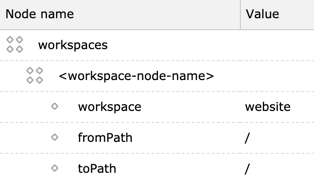
| Property | Description |
|---|---|
|
required Name of the workspace. |
|
required Workspace path on the author instance from which content is published. For a single site, enter the site node such as A trailing slash in the path limits the published content to the subnodes: |
|
required Workspace path on the public instance to which the content is published. |
|
optional, default is A Node2Bean
property that turns the mapping on ( |
|
optional, default is The This property allows you to define exceptions such as "Publish
everything in the |
| Receivers can receive any content item: websites, website sections, configuration settings, custom content types, forums, comments, documents, images and so on. For example, you could publish a campaign site to a dedicated public instance. |
Multiple receivers
In DX Core, the author instance can publish content to multiple receivers. Receivers are key to building high-availability, load-balanced environments since they can be configured to receive targeted content. See Creating a new public instance.
Typically, each receiver resides on a separate server. In the example
below, productionOne and productionTwo are receivers. Each has a
unique domain name (siteone, sitetwo) so they likely to receive
different content.
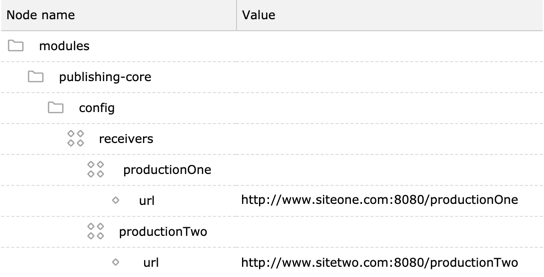
Once you have your production environment established, it is recommended
that you delete the default magnoliaPublic8080 receiver. This avoids
unnecessary errors in log files that may obfuscate errors from the
actual receivers.
Use cases
Site-specific receivers
Magnolia’s multisite feature allows you to manage many sites on one author instance. You can configure a separate receiver for each site. When content from one site is published, it goes only to the receiver configured for that site.
In the example below, a public corporate website, an extranet site and
an intranet site are all managed on the same author instance. Receivers
public, extranet and intranet are bound with the corresponding
sites. For example, the intranet receiver is bound with content in the
/intranet site. Content on that site is published to the
magnoliaIntranet public instance.
This kind of configuration simplifies the security setup. You don’t need
to segregate anonymous visitors from authenticated intranet visitors
since no intranet content is ever published to the magnoliaPublic
instance. Intranet content is published only to magnoliaIntranet which
is a completely different instance.

Flat authoring
Receiver configuration can turn a hierarchical site structure to a flat one or vice versa. Editors may prefer a flat hierarchy on the author instance. For example, a busy site section such as news is edited several times a day. If that section resides deep in the site hierarchy, it takes editors too much time to navigate the tree. Make an editor’s life easier by moving the news section to the root level on the author instance. Adding news is now quicker. The receiver configuration publishes the news pages to their intended deeper location on the public instance.
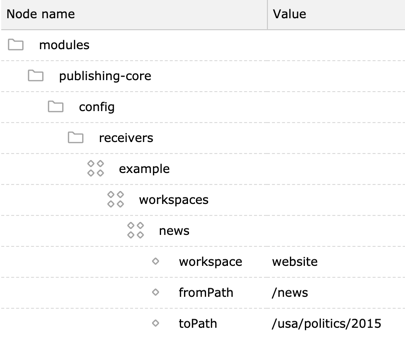
Flat public site
An opposite example is a flat public site. Search engines prefer a shallow site structure. As a rule of thumb, the flatter the public structure the better. The higher a page appears in the site structure, the more likely it will be ranked high by a crawler.
In this example, news pages are published from a deep authoring location
/usa/politics/2015 to a more SEO-favorable /news.
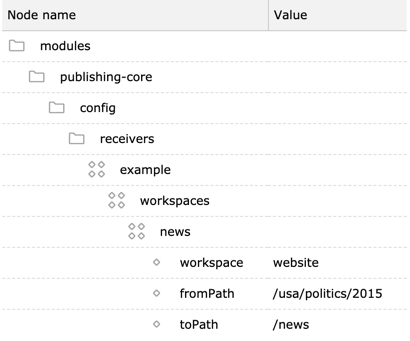
Publishing multiple sites to the same public instance
The demo websites /travel and /sportstation that ship with the
Magnolia Travel Demo bundle are an example of publishing two different
sites to the same public instance. No configuration is necessary for the
website workspace, though. By default all workspaces are attached
automatically to the magnoliaPublic8080 receiver.
Publishing the same content to multiple public instances
You can publish the same content to many sites. A corporation with regional affiliates may want to keep branding under tight control. Company logos, slogans and boilerplate text must be displayed on affiliate sites in exactly the same way.
Suppose that the corporation stores branding material such as logos in
the dam workspace in the /branding folder. In this example, the
brand material is published to the corporation’s affiliate sites for
Asia and Europe. While the content is the same, you can publish it to a
different location on the target sites depending on how those sites are
organized:
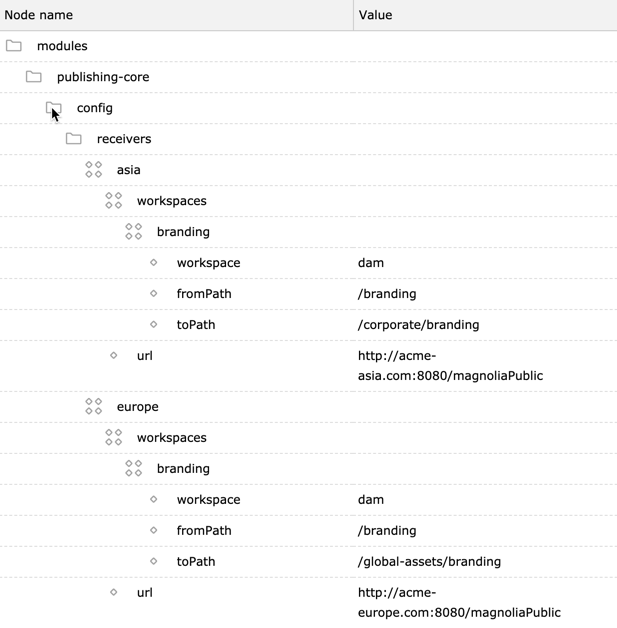
Publishing content from multiple author instances
Publishing content from multiple author instances to the same public instance can be useful when:
-
You serve multiple websites from the same server. The server may be specifically designed to serve a particular type of content (files, video).
-
Different editorial teams contribute content to the same site. For example, a finance news team in Asia writes about Asian markets on their own author instance. However, they publish the content to a U.S.-based public site.
|
Multiple author instances do not know about each other, which can lead
to conflicts. When one user working on |
Publishing heavy binary content to a dedicated instance
You can publish large binary content such as video to a dedicated public instance that acts as a media server. Compared to other public instances, the media server may have more disk space or it may be configured specifically for video streaming. Other public instances serve HTML on their own but link to videos on the media instance.